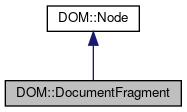KHTML
#include <dom_doc.h>

Protected Member Functions | |
| DocumentFragment (DocumentFragmentImpl *i) | |
Additional Inherited Members | |
 Public Types inherited from DOM::Node Public Types inherited from DOM::Node | |
| enum | DocumentPosition { DOCUMENT_POSITION_DISCONNECTED = 0x01, DOCUMENT_POSITION_PRECEDING = 0x02, DOCUMENT_POSITION_FOLLOWING = 0x04, DOCUMENT_POSITION_CONTAINS = 0x08, DOCUMENT_POSITION_CONTAINED_BY = 0x10, DOCUMENT_POSITION_IMPLEMENTATION_SPECIFIC = 0x20 } |
| enum | NodeType { ELEMENT_NODE = 1, ATTRIBUTE_NODE = 2, TEXT_NODE = 3, CDATA_SECTION_NODE = 4, ENTITY_REFERENCE_NODE = 5, ENTITY_NODE = 6, PROCESSING_INSTRUCTION_NODE = 7, COMMENT_NODE = 8, DOCUMENT_NODE = 9, DOCUMENT_TYPE_NODE = 10, DOCUMENT_FRAGMENT_NODE = 11, NOTATION_NODE = 12, XPATH_NAMESPACE_NODE = 13 } |
 Protected Attributes inherited from DOM::Node Protected Attributes inherited from DOM::Node | |
| NodeImpl * | impl |
Detailed Description
DocumentFragment is a "lightweight" or "minimal" Document object.
It is very common to want to be able to extract a portion of a document's tree or to create a new fragment of a document. Imagine implementing a user command like cut or rearranging a document by moving fragments around. It is desirable to have an object which can hold such fragments and it is quite natural to use a Node for this purpose. While it is true that a Document object could fulfil this role, a Document object can potentially be a heavyweight object, depending on the underlying implementation. What is really needed for this is a very lightweight object. DocumentFragment is such an object.
Furthermore, various operations – such as inserting nodes as children of another Node – may take DocumentFragment objects as arguments; this results in all the child nodes of the DocumentFragment being moved to the child list of this node.
The children of a DocumentFragment node are zero or more nodes representing the tops of any sub-trees defining the structure of the document. DocumentFragment nodes do not need to be well-formed XML documents (although they do need to follow the rules imposed upon well-formed XML parsed entities, which can have multiple top nodes). For example, a DocumentFragment might have only one child and that child node could be a Text node. Such a structure model represents neither an HTML document nor a well-formed XML document.
When a DocumentFragment is inserted into a Document (or indeed any other Node that may take children) the children of the DocumentFragment and not the DocumentFragment itself are inserted into the Node . This makes the DocumentFragment very useful when the user wishes to create nodes that are siblings; the DocumentFragment acts as the parent of these nodes so that the user can use the standard methods from the Node interface, such as insertBefore() and appendChild() .
Constructor & Destructor Documentation
| DOM::DocumentFragment::DocumentFragment | ( | ) |
Definition at line 634 of file dom_doc.cpp.
| DOM::DocumentFragment::DocumentFragment | ( | const DocumentFragment & | other | ) |
Definition at line 638 of file dom_doc.cpp.
|
inline |
| DOM::DocumentFragment::~DocumentFragment | ( | ) |
Definition at line 662 of file dom_doc.cpp.
|
protected |
Definition at line 686 of file dom_doc.cpp.
Member Function Documentation
| DocumentFragment & DOM::DocumentFragment::operator= | ( | const Node & | other | ) |
Definition at line 642 of file dom_doc.cpp.
| DocumentFragment & DOM::DocumentFragment::operator= | ( | const DocumentFragment & | other | ) |
Definition at line 656 of file dom_doc.cpp.
Introduced in Selectors Level 1.
Returns the first (in document order) element in this fragment matching the given CSS selector query.
- Since
- 4.5
Definition at line 666 of file dom_doc.cpp.
Introduced in Selectors Level 1.
Returns all (in document order) elements in this fragment matching the given CSS selector query. Note that the returned NodeList is static and not live, and will not be updated when the document changes
- Since
- 4.5
Definition at line 676 of file dom_doc.cpp.
The documentation for this class was generated from the following files:
Documentation copyright © 1996-2020 The KDE developers.
Generated on Mon Jun 22 2020 13:26:20 by doxygen 1.8.7 written by Dimitri van Heesch, © 1997-2006
KDE's Doxygen guidelines are available online.
 KDE API Reference
KDE API Reference